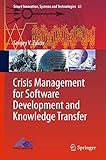Crisis Management for Software Development and Knowledge Transfer [electronic resource] / by Sergey V. Zykov.
By: Zykov, Sergey V [author.].
Contributor(s): SpringerLink (Online service).
Material type: BookSeries: Smart Innovation, Systems and Technologies: 61Publisher: Cham : Springer International Publishing : Imprint: Springer, 2016Description: XXIII, 133 p. 37 illus., 13 illus. in color. online resource.Content type: text Media type: computer Carrier type: online resourceISBN: 9783319429663.Subject(s): Engineering | Software engineering | Artificial intelligence | Computational intelligence | Engineering | Computational Intelligence | Artificial Intelligence (incl. Robotics) | Software Engineering/Programming and Operating SystemsAdditional physical formats: Printed edition:: No titleDDC classification: 006.3 Online resources: Click here to access online
BookSeries: Smart Innovation, Systems and Technologies: 61Publisher: Cham : Springer International Publishing : Imprint: Springer, 2016Description: XXIII, 133 p. 37 illus., 13 illus. in color. online resource.Content type: text Media type: computer Carrier type: online resourceISBN: 9783319429663.Subject(s): Engineering | Software engineering | Artificial intelligence | Computational intelligence | Engineering | Computational Intelligence | Artificial Intelligence (incl. Robotics) | Software Engineering/Programming and Operating SystemsAdditional physical formats: Printed edition:: No titleDDC classification: 006.3 Online resources: Click here to access online Introduction -- Software Engineering: the End of the Crisis? -- Software Lifecycles: How Can we Optimize them? -- Software Methodologies: Are our Processes Crisis-Agile? -- Software Patterns: Ready for Crisis Development? -- Knowledge Transfer: Manageable in Crisis? -- Conclusion.
This well structured book discusses lifecycle optimization of software projects for crisis management by means of software engineering methods and tools. Its outcomes are based on lessons learned from the software engineering crisis which started in the 1960s. The book presents a systematic approach to overcome the crisis in software engineering depends which not only depends on technology-related but also on human-related factors. It proposes an adaptive methodology for software product development, which optimizes the software product lifecycle in order to avoid "local" crises of software production. The general lifecycle pattern and its stages are discussed, and their impact on the time and budget of the software product development is analyzed. The book identifies key advantages and disadvantages for various models selected and concludes that there is no "silver bullet", or universal model, which suits all software products equally well. It approaches software architecture in terms of process, data and system perspectives and proposes an incremental methodology for crisis-agile development of large-scale, distributed heterogeneous applications. The book introduces a number of specialized approaches which are widely used in industry but are often ignored in general writings because of their vendor-specificity. In doing so, the book builds a helpful bridge from academic conceptions of software engineering to the world of software engineering practice. With its systematic coverage of different software engineering methodologies and the presented rich systems engineering examples the book will be beneficial for a broader audience.


There are no comments for this item.